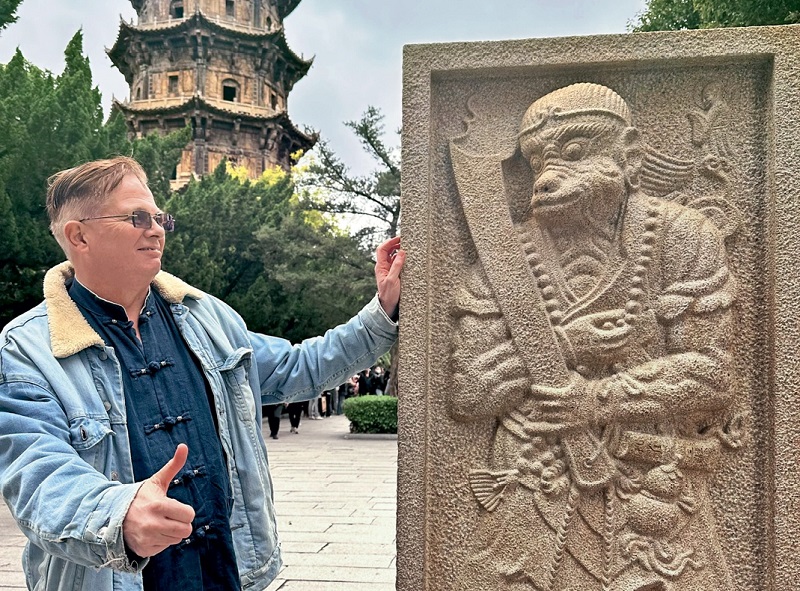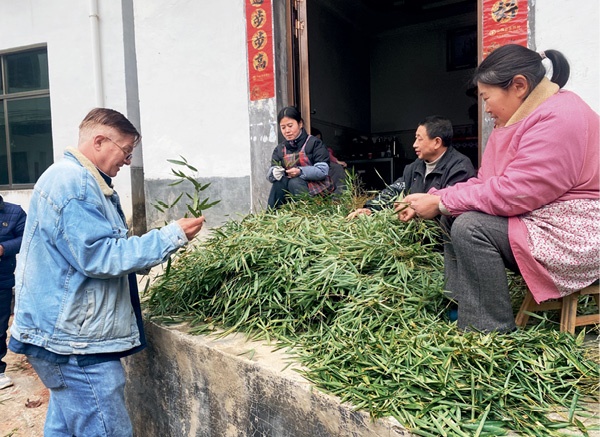
Chris Nash, former chairman of the Society for Anglo-Chinese Understanding, shows his respect to the statue of Sun Wukong, or the Monkey King, which comes from the 16th-century classic Journey to the West, at Kaiyuan Temple in Quanzhou, Fujian Province.
 I took a step back, surrounded by the iconic black and white harmony of the architecture of Xidi, admiring the elegant characters above a door lintel: “The falling leaf returns to its roots.” Xidi is an ancient village in Anhui Province in east China, near the Huangshan Mountain, a popular scenic area. It has been recognized by the UNESCO as a World Heritage Site.
I took a step back, surrounded by the iconic black and white harmony of the architecture of Xidi, admiring the elegant characters above a door lintel: “The falling leaf returns to its roots.” Xidi is an ancient village in Anhui Province in east China, near the Huangshan Mountain, a popular scenic area. It has been recognized by the UNESCO as a World Heritage Site.My knowledgeable guide recounted fascinating history of how past residents of the area had spread like the boughs of an ever-branching tree across China, carrying with them tea for nurturing the body, inkstones for nurturing the culture, and philosophies to nurture the mind, and then returning in the autumn of their years.
The poetry stirred something in me and I remembered all the welcoming faces and smiling eyes I had met in my three weeks of travel from Beijing, through Anyang and Kaifeng in central China, across to Quanzhou in Fujian Province in the southeast, and then northward to Wuyuan County, near the Huangshan Mountain. Wasn’t I like a falling leaf, a foreign leaf falling from the treetop in Beijing, finding a home in the roots of China everywhere I traveled? The real meaning of those weeks on the road was not only about history, culture, and beauty, but essentially about the open hearts and minds of people along the way, who were happy to make a traveler welcome among their roots, if you can take just a few steps outside of yourself.

Chris Nash helps villagers make brooms in Xiaoxi Village, located in Anhui Province's Huangshan City.
People Mountain, People Sea
Join me now at the Beijing South Railway Station and I’ll share some of the amazing experiences of my journey. Why did I choose to travel by the high-speed railway service, especially at the peak season, during the Spring Festival? Well, apart from the sheer comfort and convenience of these engineering marvels that glide electrically across the whole country with incredible punctuality, for me rail travel is an essential part of the festival spirit. Yes, both stations and trains are crowded with “renshan-renhai,” a Chinese saying which means crowds of people as big as mountains and as vast as the sea, returning home for their relatives, but whether they are migrant workers, weighed down with presents for their relatives back home, families humming with the expectation of being re-united with grandmas, grandpas, aunties, and uncles, or elegant singles, shiny with fashion brands to show their quietly proud parents, the high-speed railway carriages are the first part of the hometown feeling.
My first destination was Anyang, a city in Henan Province. My Didi (the Chinese Uber) took me into a smart, well developed comfortable city, but I couldn’t help feeling a small sense of disappointment in such modern comforts, because I was on the trail of the Shang Dynasty, the historical and legendary culture which shaped China between 1600 and 1046 B.C. and which had as its capital ancient Anyang, then known as Yin. But I needn’t have worried, the Shang was waiting for me in the glories of the Yinxu Museum.
The Yinxu Museum, opened in 2024, is located close to the site of the ancient Shang palace and is one of a number of incredible museum projects across China that bring you face to face with the deep past. You can see for yourself the origins of Chinese characters in the faint scratches on mysterious oracle bones and hypermodern electronic displays show their evolution into modern characters. As the headteacher of an international school, I am always looking for global connections to share with my students and I was enthralled by the artistry of the bronze ware. At the time they were crafted, the skills of bronze working were just being learned in Britain. There is nothing to compare to the accomplishments of the Shang artists, shown for example, in the intricacy and power of a bronze buffalo vessel found in the tomb of Ya Zhang, a well-known military general of the Shang Dynasty.
But there is a link. In both East and West, you can see the fascination of these workers of molten metal with animal forms and shapes, using images of beasts and birds repeatedly to decorate vessels for eating, drinking, and rituals.
Speaking of eating and drinking, my next warm encounter with local culture came in my next city of Kaifeng. Just like Anyang, I was mainly in Kaifeng to rediscover another ancient dynasty, the Song (960-1279), when the city was the capital of China. This Song legacy can best be appreciated by visiting the Iron Pagoda, first constructed in 1049. (For British readers, that was just like the Anglo-Saxon period which was about to end at the Battle of Hastings). As Kaifeng has a claim to being the first metropolis in the world, so is the Iron Pagoda described as the first pagoda in the world. Just as the churches in Anglo-Saxon England are signs of British connections to a wider world, so do the pagodas show China’s influence on the spread of Buddhist culture across the Asian world at that time.
But we must have food for the stomach as well as the soul! Just as legendary as the Iron Pagoda is the “Four Meat Noodles” of the Liji Siwei restaurant in Beishudian Street. Join the lengthy queue outside for a delicious broth with handmade noodles and fresh cut carvings of the four meats served with a chunk of just baked flatbread that you can scrunch up and dip in your dish like the more famous paomo from Shaanxi. The restaurant is tiny, so you sit cheek by jowl with the locals, immersed in the friendly, noisy sipping and slurping of this unique experience.

Chris Nash experiences the beautiful local culture in Quanzhou, Fujian Province.
 A Face of Chinese Internationalism
A Face of Chinese Internationalism After the culture and history of central China, I was ready to head south. My chosen destination was Quanzhou. In fact, my very first visit to China had been to the nearby port city of Xiamen and it had been a case of yijian-qingxin, love at first sight, and I was keen to see if Quanzhou could work the same magic. I needn’t have worried, it could and did, with its own mix of deep local and international culture.
It’s the second of February and I’m in the seaside area of Xunpu, in a small square, immersed in the laughing and dancing of a lively crowd as they enjoy a series of Spring Festival shows, a mix of the well-known performances, such as a lion dance, and others unique to Quanzhou, such as celebrations of Mazu, the Goddess of the Sea and the protector of fishing communities there. After a lunch of the local specialty, an oyster omlet, you wander around nearby Wulin and meet another face of Chinese internationalism.
In Wulin you are surrounded by red brick villas that are the most intriguing combinations of Chinese, Western and even Islamic influences, with Greek columns supporting the shapely swallowtail roofs typical of local Minnan architecture and intricate brick tile patterns usually seen in Muslim buildings. These fabulous houses are living evidence of overseas Chinese who in the late 19th and early 20th centuries lived and worked in countries around southeast Asia, sending remittances home to families in Wulin to build these impressive homes. In modern-day Quanzhou, you will see the same spirit and ambition among the entrepreneurs of today.
Guardians of Cultural Heritage
And so to my final destination, Wuyuan! I’m sure you don’t need me to tell you about the soulful harmonies of villages such as Xidi and Hongcun, another UNESCO World Heritage Site. These are well-known from photographs and films. Instead I want to talk about the beautiful hearts of the village people, beautiful despite the fact that life in these areas is not easy even with the rural revitalization. I mean people like Wang Wenxuan and his wife Dai Jing, owners of the Wuyuan Zi Zai She homestay, who as soon as they knew of my love for Chinese arts introduced me to Wu Jinhua, an outstanding carver of local inkstones, and Yu Xiaoqun, an amazing wood carver. People like these are the guardians and communicators of the area’s intangible cultural heritage.
Then there were the warm-hearted villagers who embraced me in their simple lives: the girls in Xiaoqi who giggled at my beginner’s Chinese and answered my silly questions about life for young people in the village; the carpenter in Qingyuan Village who shared his life story while strenuously stripping a local tree to handcraft a ladder for a neighbor, and the elders in Bishan who welcomed me into their home and shared the secrets of their local heating system, the huotong, or “fire bucket,” chatting away like old friends. From the foreign leaf who fell to your organic local roots, a very sincere thank you.
In conclusion, to my Chinese friends I want to say, cherish the roots of your modern lives and join the great project of your country to preserve these treasures as vital parts of the great, diverse eco-system that is your inheritance. And to my foreign friends I want to say China is open and waiting for you with open arms. Take China into your heart and she will reward you with experiences that will last a lifetime. 
CHRIS NASH is former chairman of the Society for Anglo-Chinese Understanding.